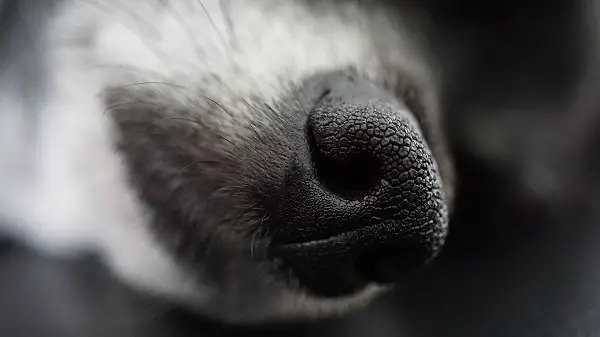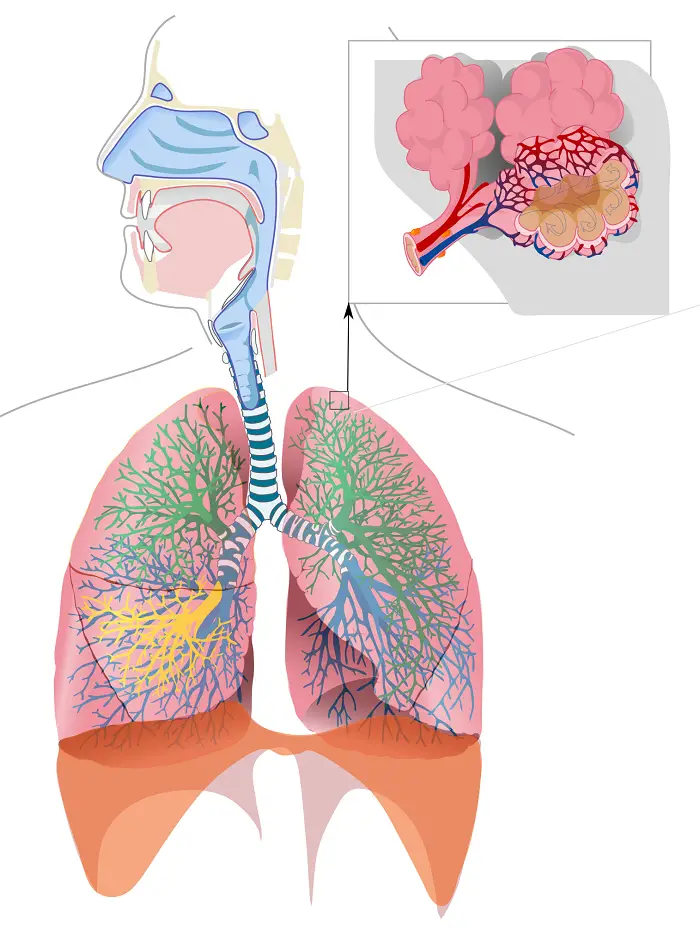Respiratory System
The respiratory system is responsible for exchanging gases with the environment, supplying the blood with O2, and disposing of CO2.
How Animals Breathe: An Overview
Gas exchange enables us to harvest the energy from the food molecules the digestive system provides. Three phases of gas exchange occur in air-breathing animals:
- Breathing
- Transport of gases by the circulatory system
- Exchange of gases with body cells
The gas exchange occurring as we breathe is often called respiration and the respiratory system is the organ system facilitating this process. The part of an animal’s body where gas exchange occurs is called the respiratory surface which is made up of living cells that are wet to be able to function properly. Thus, respiratory surfaces are always moist.
Gas exchange occurs by diffusion and having a large surface area allows sufficient oxygen (O2) to diffuse rapidly for every cell in the body.
The skin-breathers, such as earthworms, must live in damp places to facilitate gas exchange. These animals are generally small and many are long, thin, or flattened. These shapes provide a high ratio of respiratory surface to body volume, allowing sufficient gas exchange for the cells of their body.
In most animals, the skin surface isn’t extensive enough to sustain the gas exchange required by the body. Many have adaptations that improve ventilation, the flow of water or air over the respiratory surface. These adaptations include gills, tracheal systems, and lungs.

The gills evolved in most aquatic animals are extensions of their body surfaces for gas exchange. Marine worms have flap-like gills per segment while a fish has a set of feather-like gills on each side of its head. Because the respiratory surfaces of aquatic animals extend into the surrounding water, keeping the surface moist isn’t a problem.
In most terrestrial animals, the respiratory surface is folded into the body rather than projecting from it. The enfolded surface opens to air through narrow tubes which helps retain moisture. The tracheal systems of insects are air tubes that extend throughout their bodies. Thus, gas exchange in insects does not require assistance from the circulatory system. Meanwhile, most terrestrial vertebrates have lungs, internal sacs lined with moist epithelium.
Animals have complex breathing mechanisms already and as you might infer from the pattern of this part of the reviewer, we will also examine how these mechanisms play out in the human body.
The Human Respiratory System
Air enters our respiratory system through our nostrils where it is filtered by hairs, warmed, humidified, and sampled for odors as it flows through our nasal cavity. We could also breathe through our mouth but it won’t be capable of filtering the air as our nasal cavity does.
From the nasal cavity or mouth, air passes into the pharynx, a common passageway for air and food. When swallowing food, the larynx (upper part of the respiratory tract) moves upward and tips the epiglottis over the opening of our trachea or windpipe. The rest of the time, the passage in the pharynx is open for breathing.
The larynx is often called the voice box. Our vocal cords are found here and when air vibrates muscles that stretch the cords, the sound is produced.

Rings of cartilage reinforce the walls of the larynx and trachea, keeping the airway open. The trachea separates into two bronchi which branch repeatedly into finer and finer tubes called bronchioles. The bronchioles end in grape-like clusters of air sacs called alveoli with each of our lungs containing millions of these tiny air sacs.
The lungs are located in our chest, or thoracic cavity, protected by our rib cage. The thoracic cavity is separated from the abdominal cavity by a sheet of muscle called the diaphragm which functions in breathing.
Breathing is the ventilation of the lungs through alternating inhalation and exhalation. In humans and other animals, ventilation occurs by negative pressure breathing which allows air to be pulled into the lungs. How does this work? The key is to create a pressure gradient by changing the volume of the lungs (In chemistry, the pressure exerted by a gas varies inversely with volume).
During inhalation, muscles in the ribs contract causing the ribs to move upward while the diaphragm contracts and moves downward. The contraction expands the volume of the thoracic cavity and the lungs expand. Air pressure in the alveoli decreases – becoming lower than atmospheric pressure (i.e., negative relative to it) and because air is a fluid, it moves from high to low concentration and this means we inhale it. Exhalation reverses this pressure concentration in that when the rib muscles and diaphragm relax, the lungs return to their unstretched positions, forcing air out of the body.
The maximum volume of air that can be inhaled and exhaled with each breath is our vital capacity. Control of breathing is most of the time involuntary, with parts of the brain mediating the process. We will learn about them later but more important to us is the question: “How does the oxygen from the lungs enter all other tissues in the body? How is carbon dioxide removed from it?” The answer to that lies in the circulatory system, which we’ll cover next.
Next topic: Circulatory System
Previous topic: Digestive System
Return to the main article: Animal Form and Functions (Overview)
Download Article in PDF Format.
Test Yourself!
1. Practice Questions [PDF Download]
2. Answer Key [PDF Download]
Copyright Notice
All materials contained on this site are protected by the Republic of the Philippines copyright law and may not be reproduced, distributed, transmitted, displayed, published, or broadcast without the prior written permission of filipiknow.net or in the case of third party materials, the owner of that content. You may not alter or remove any trademark, copyright, or other notice from copies of the content. Be warned that we have already reported and helped terminate several websites and YouTube channels for blatantly stealing our content. If you wish to use filipiknow.net content for commercial purposes, such as for content syndication, etc., please contact us at legal(at)filipiknow(dot)net